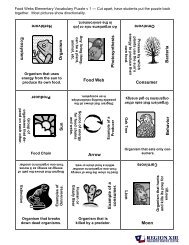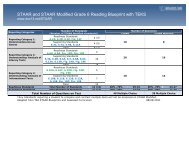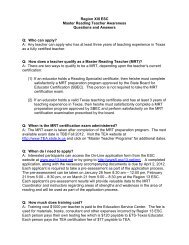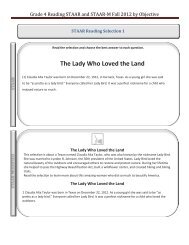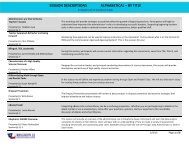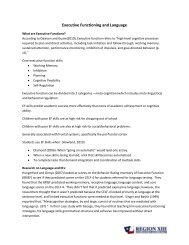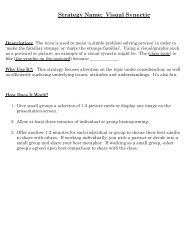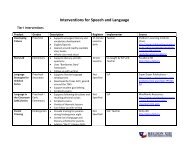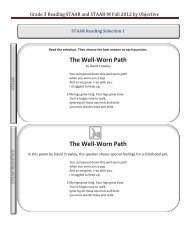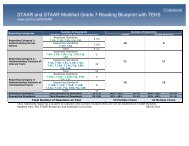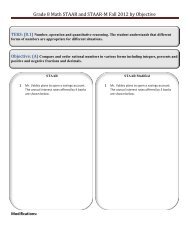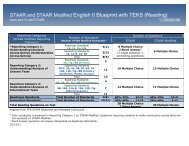2nd Six Weeks Newsletter - Region 13
2nd Six Weeks Newsletter - Region 13
2nd Six Weeks Newsletter - Region 13
Create successful ePaper yourself
Turn your PDF publications into a flip-book with our unique Google optimized e-Paper software.
nect all operations of fractions and decimals.2010—2011 Second <strong>Six</strong> <strong>Weeks</strong> PreviewMathematicsUnit 5: Algebraic Expressions and Equations. This unit bundles students expectations that address generating formulas,graphing data, solving equations using concrete and pictorial models and symbols, selecting the appropriate operations,and justifying the reasonableness of solutions in order to build algebraic reasoning.Prior to the unit, in Unit 4, the students investigated operations with decimals and fractions. The study of the operationsof addition, subtraction, multiplication, and division of integers, fractions, and decimals is reinforced in Unit 5 by solvingformulas involving unit conversions, perimeter, area, circumference, volume, and scaling. The ability to estimate and justifythe reasonableness of solutions will help students as they investigate the relationship between different representations(i.e., numerical, geometric, verbal, and symbolic). This lays the foundation for the investigation of proportional relationshipsin Unit 7, Unit 8 and Unit 14.Unit 6: Order of Operations. This unit bundles student expectations that address squares, square roots and order ofoperations in order to investigate patterns and models looking for relationships that play a key role in geometric formulasand algebraic reasoning.Prior to this unit, in Grade 6, students were exposed to the squaring of numbers when using the area of a circle formula.In Grade 7, students will investigate squares and square roots using models and patterns. Squares and square roots ofnumbers relates to the area of squares and circles. Grade 6 used order of operations without exponents. Grade 7 willsimplify expressions using order of operation, including exponents. Order of operations is required when working withformulas such as the perimeter of a rectangle, the area of a circle, or the area of a trapezoid. Grade 8 applies squares,square roots and order of operations to topics such as the Pythagorean Theorem, algebraic expression, formulas, etc.,which are important concepts that extend to Algebra I and beyond.8 th GradeUnit 4: Proportions. This unit bundles student expectations that address proportional and non-proportional relationships.The goal of this unit is for students to understand the difference between proportional and non-proportional relationships,how to build proportions from ratios, how to compare two quantities that are written in the form of a ratio, andto continue the development of proportional thinking through problem-based concepts.Prior to this unit, in Grade 7, students solved a variety of problems involving unit rate and percent. These problems areextended to more complicated situations in Grade 8. In Grade 6, students compared the difference between proportionaland non-proportional relationships. The discussion of proportional and non-proportional relationships in this unit continuesto lay the groundwork for the understanding of function in Algebra I.Unit 5: Algebraic Representations. This unit bundles student expectations that address sequences, representations ofdata (tables, equations, verbal descriptions, and graphs), and solving equations.Prior to this unit, in Unit 4, the development of proportional thinking and constant rate of change through problem-basedcontexts was addressed. Unit 5 continues the development of proportional thinking through linear equations and arithmeticsequences with a constant rate of change. Students investigate methods for solving linear equations with the use ofconcrete models, graphs, and tables. Throughout elementary and middle school, students have used tables, graphs,verbal descriptions, and equations to solve problems. In Grade 7, they learned to solve equations using models. InGrade 8, these four representations of data merge so that students interchange them flexibly when solving problems andsolidify their understanding of solving equations. This expectation is carried over to Algebra I. Sequencing instructionfrom concrete, through the pictorial, to the abstract gives students several ways to understand algebraic problems. Sincestudents come to school with varied backgrounds and learning styles, this approach also bridges the gap between informalunderstandings to abstract understanding.Algebra IUnit 2: Linear Equations and Inequalities. The student expectations bundled in this unit involve connections betweenfunctions and equations. In order to conceptually develop an understanding of equations and inequalities, students willformulate equations and inequalities from problem situations, apply various methods including models, tables, graphs,and algebraic properties to solve equations, and analyze the solutions.15



